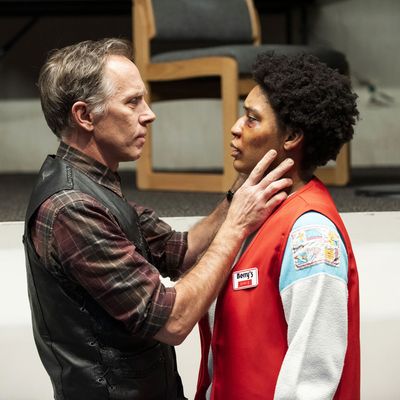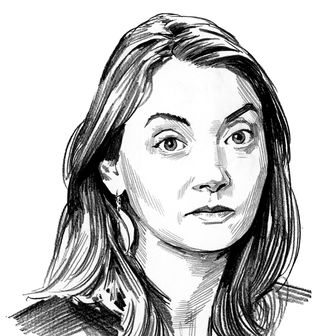
Eboni Booth’s naturalistic thriller Paris is technically a period piece. It’s set in 1995, in Paris, Vermont: People are wearing terrible mauve windbreakers, and the haircuts are tragic. But the scope of Booth’s drama doesn’t belong to the past. It’s a fierce distillation of life under modern precarity, a horror play that only uses reality for its big scares.
We begin in a breakroom that looks like a bomb shelter, watching the employee orientation film for a Wal-mart-ish store called Barry’s. Something about the scratchy old video tape with its Van Halen riffs seems hilarious—as with the show’s eye-searing 1990s fashion, each throwback touch amuses us. We giggle (why on earth did we wear that?), fractionally delaying our recognition of some workplace insult. In this case, the cheeseball cinematography distracts us enough that the anti-union message comes before we’re ready. Welcome to the Barry’s family, the video says, the kind of family where you will absolutely not organize lest we take you to goddamn court.
Emmie (Jules Latimer) is experiencing the special agony of the interviewee who cannot tell if her interviewer, the manager Gar (Eddie K. Robinson), has given her the job or not. He keeps asking random questions she’s eager to answer (“Name your favorite Talking Heads song!”), but the stockroom position seems to already be hers. This teetering feeling never actually ends. Emmie works at Barry’s for the show’s 90 minutes, but in every anxious second you feel that she might be fired—the five bucks an hour that she needs so badly snatched back. This pit yawns under everyone who works there: Wendy (Ann McDonough), the wily old hand with the soft heart; Logan (Christopher Dylan White), the itchy stoner with dreams of emcee stardom; and Maxine (Danielle Skraastad), the rage-filled mother of three.
Director Knud Adams frames the production like a horror movie. He has thought carefully about the way our eyes move through David Zinn’s photorealistic set (the break room above on a concrete shelf, the stockroom below and seeming to extend into the theater’s own lobby), so that the spaces, even empty, throb with menace. Each element—from Oona Curley’s lights to Arnulfo Maldonado’s costumes to Fan Zhang’s sound—has this cinematic precision. And his cast is perfect from stem to stern, all of them hilarious and dangerous by turns, surrounding the quivering Latimer, who lies still as a rabbit at the show’s center.
Booth seems to have had only one compositional rule: Every conversation must revolve around money. Wendy’s husband Dev (James Murtaugh) keeps hawking a series of books about how to be a millionaire; Logan needs to sell tickets for his band to be allowed to keep his (terrible) musical career going. Gradually, though, she shows her hand as a plotter—slipping thriller elements into her Nickel and Dimed realism. Things at Barry’s aren’t all what they seem. The merchandise looks like garbage, but it’s is worth more than a human life. Gar’s law-and-order strictness sometimes softens—Emmie and he have a moment of solidarity over being black in Vermont—and then turns sly. At one point, when Bruce McKenzie oozes onstage as the mysterious Carlisle, the play feels like it’s about to turn on a Tarentino dime. But the horrors of life under at-will employment are frightening enough. The chill of this show went so deep, I found myself walking around in the snow afterwards, begging my heart to warm up.
Then there’s an actual horror play, The Woman in Black, though it’s the kind of horror that’s supposed to make you feel better instead of worse. Because whatever your issues are, I bet you’re not being pursued by an eldritch figure out of a nightmare, a black-clad figure stalking you through sea mists and treacherous marshes. I mean, not unless you’re on the campaign trail! Ha-ha, we’re in hell.
Susan Hill’s 1983 novel is fake Victoriana, crammed full with atmosphere. Clearly an admirer of Henry James, Hill wrapped her narrative in one of those gothic 19th century framing stories; her 1987 adaptor Stephen Mallatratt then enfolded her double-layered plot in yet another dramaturgical shell. (This seems like a mistake—putting a hat on a hat.) The nervous ex-solicitor Arthur Kipps (David Acton) has written down his “real” tale to get it off his chest; Mallatratt invents an Actor (Ben Porter), who coaches Kipps in adapting it for the stage and eventually plays his part. Kipps’s story follows old ghost story rules: People warn him about staying overnight in a haunted house; he has several macabre encounters; then he reads a packet of expositional letters.
The Woman in Black is helpfully subtitled A Ghost Play in a Pub, so that we know that an important part of our night will be drinking. The pretty wood-paneled bar at the McKittrick Hotel (better known as the host of Sleep No More) provides as many grogs and ales as ye can get down ye, and if you evaluate good pub entertainment as “freaked people out enough to kick over their own beers,” this show gets the Sticky Floor Award. The night I saw it there was a certain credulousness in the room that might have been the booze’s work. People shouted aloud, cried a warning to a character in the play, and applauded when a performer swished his walking stick jauntily.
Mallatratt’s play has been playing the West End in London for 30 years and has gone on 14 tours. The original commissioning director, Robin Herford, has directed every cast, including this one. So the bones in this thing are sturdy. You could bludgeon other shows to death with those bones. But while the scares are loud, they partly make you jump because the first twenty minutes of repetitive introduction have lulled you to sleep. The drama’s been overbuilt by almost an hour, perhaps so there will be time for an intermission and further trips to the bar. It will, of course, be a matter of taste as to whether you find this chestnut comfortingly classic or morbidly stale. To me, it seemed like a zombie version of something that had once had life. This show clearly knows a thing or two about refusing to die.
Paris is at the Atlantic Theater Company’s Stage 2.
The Woman in Black is at the McKittrick Hotel.





